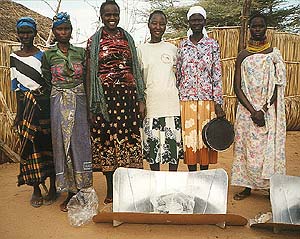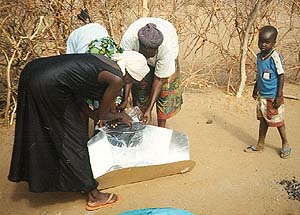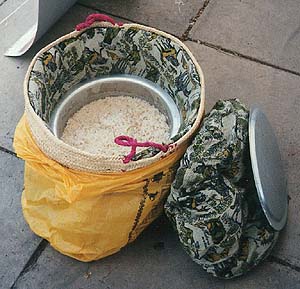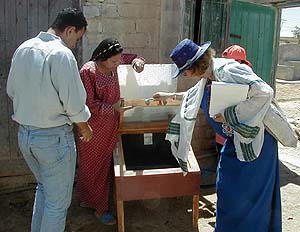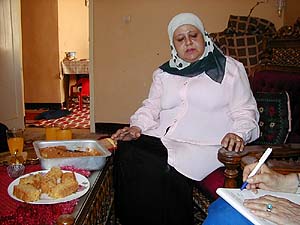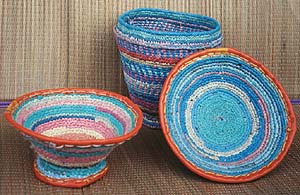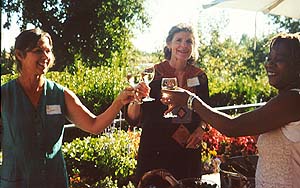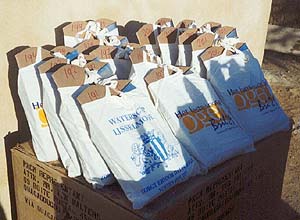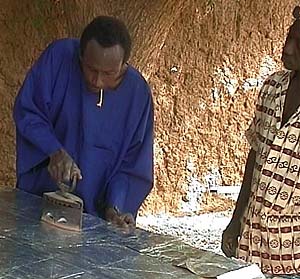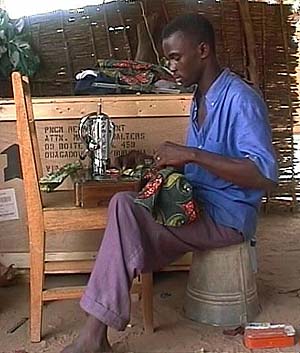| Solar Cookers International 1919 21st Street, #101 Sacramento, CA 95811 USA Tel. 916-455-4499 Fax 916-455-4498 E-mail: info@solarcookers.org |
Solar Cooker Review December 2000 |
Solar Cooking
Archive: |
| Volume 6, Number 3 Back Issues E-mail PDF |
|
In This Issue
- Refugee Projects On Track
- Solar Water Pasteurization in Tanzania
- News You Send
- President's Corner
- Egyptian University Graduates Discover Solar Cooking Benefits
- Rotary / Girl Guide Partnerships
- The Benefits of Planned Giving
- Willing Ways and the Power to Do Good
- Shine On and On!
- CooKit Use and Marketing Taught in Burkina Faso
by Terry Grumley SCI Executive Director
In spite of adverse conditions in the areas where we carry out programs, SCI is firmly moving forward towards achievement of the Year 2000 Program Objectives identified for projects in Kenya, Ethiopia and Zimbabwe. These objectives include both quantitative targets as well as qualitative improvements that make us more effective in spreading solar cooking and reducing fuelwood usage. In Kenya and Ethiopia, we will easily meet the original targets set. While in Zimbabwe we have had to scale back from our original target of 3,000 new families trained and CooKits distributed to 1,000, we are making major progress with our partner organization, the Development Technology Centre (DTC) of the University of Zimbabwe. Together we have revamped the project, placing more emphasis on sustainability through a women's income generation component. Highlights of the progress in each project are described below.
Local Kenyan women trained to solar cook by SCI's Shadrack Alumai
Kenya - Kakuma Refugee Camp
We will easily meet our target to train 4,000 new families and distribute 4,000 CooKits this year. In spite of the severe power outages in Nairobi which have affected our office operations as well as the manufacture of cooking bags, 1,520 CooKits were distributed from January to July leaving 2,500 CooKits to be distributed the remainder of the year with the normal program of 60 workshops given per month. There was a reduction in training for the period of February through May due to weather, delay in CooKit manufacture and the need to conduct a camp population census exercise. Staff took advantage of this time to focus on home visits, completing 3,014 by July. 10,434 bags were distributed and 9,400 pots were repainted black during the same period.
Home visits allow for continuous training of, and feedback from, solar cooks
The preparation of a project description - with clear measurement indicators and specific timelines - is helping staff, partners and beneficiaries to analyze project experiences, learn from them and identify measures for reinforcing strengths and making improvements in areas of weakness. Another significant achievement was the completion of a training session for SCI, GTZ and JRS trainers. GTZ, a German development organization, and their local partner, JRS, promote the use of fuel-efficient stoves. The sessions gave all participants the capacity to promote four different methods for reducing fuelwood usage: 1) solar cookers, 2) fire-less cookers or hay boxes for "retained heat" cooking, 3) fuel-efficient portable stoves and 4) fuel-efficient mud stoves. The objective of the training is to insure that all energy conservation trainers working in the camp will be more effective at supporting the work of other trainers using complementary methods. This collaboration will reinforce the overall impact of our work in reducing fuelwood usage.
A fire-less cooker with rice
Aside from specific numbers, there are other important indicators that reflect the value refugees place on solar cooking. Earlier this year, another agency in the camp suffered reductions in support and had to stop providing SCI and our partner, Lutheran World Federation (LWF), with food for training programs. After consultations with LWF social services department, the project adopted a system whereby the trainees brought a little food, which was then pooled and used for food demonstrations. The significance here is the fact that the refugees have very little food, but they are willing to bring in a little so that they may save more by not bartering it away for firewood. In addition, trainees previously received some food to take home to try out solar cooking without risking their precious rations. This too has had to change, but again, family members are willing to try out solar cooking with their own food. However, trainers have created reserves for the poorest families. Even though this approach could have impacted negatively on the project, it did not, and willing users continued to come forward for training sessions.
We will easily meet our target of distributing 1,000 CooKits in Aisha this year. By the end of July, 576 CooKits were distributed to new arrivals, to large families or as replacements for damaged CooKits. The rest will be distributed during the remainder of the year. A low bag distribution of less than 1,000 indicates a lower usage than expected or, more likely, that many families are using other types of bags or cooking without bags. This is an example of improvement in measurement that helps us pinpoint areas for gathering more information and shifting our approach appropriately. The specific statistics give us firm data to use in discussions with partners and users to address the difficult balance of both promoting sustainability (charging for bags & CooKits) and also promoting increased usage (not charging for bags & CooKits). While there is never a clear-cut "right answer," the more reliable the information available, the more likely that the discussions will be constructive and the best decision will be reached. There is also evidence of a slow but significant purchase of both CooKits and bags, signaling a positive shift. The plastic weaving recycling program remains strong and is highly valued by both camp residents and our partners the United Nations High Commission for Refugees (UNHCR) and the Ethiopian government's Administration for Refugee and Returnee Affairs (ARRA). While the "work for a CooKit" program suffered a set back with the temporary stop of the tree planting program by another agency in the camp, we are looking at the possibility of promoting something similar with the idea of refugees creating rewoven plastic bag products in exchange for a CooKit. Approximately 3,000 home visits were made and 2,142 pots repainted black in the first seven months of the year. In spite of continuing efforts on SCI's part, we have yet to find an Ethiopian manufacturer to produce CooKits. On the other hand, Margaret Owino, the SCI East Africa Regional Representative, has had success in identifying and meeting with local organizations with whom we may be able to collaborate in the future and who may help us find local manufacturers.
Due to problems caused by political unrest and transportation delays from fuel shortages, the DTC team has had difficulty implementing the project according to the original plan. During this slowdown, however, we took advantage of the situation to review and revamp the project. With a more clearly defined project design that incorporates a stronger income generation component for the women trainers at each of the five sites and the assignment of additional DTC staff, the project is back on track. The margin gained on the sale of CooKits and bags is deposited into the savings account of the business unit of the solar cooker trainers. The trainers will use a designated savings balance as collateral to take a loan to buy new supplies or apply to other business activities such as the construction and sale of hay boxes. DTC, with SCI support, remains in close communication with the Zimbabwe Department of Energy and other energy conservation non-government organizations including AZTREC, GTZ and the Zimbabwe Women's Bureau. Contact is also maintained with the Rotary Club and the Hlekweni Training Center in Ntabazinduna, both of which are doing an excellent job in supporting the solar cooking project that was passed on to them after SCI and DTC initiated the project in 1996. DTC has conducted a baseline survey in each of the five current project areas that will improve our capacity to measure progress over the project cycle and beyond.
Summary
In spite of the difficult circumstances within which SCI and our partner agencies work, we are pushing ahead to reach more families while improving the quality of our services and the efficiency and effectiveness of our operations. While recognizing the need for an initial emphasis on training families and distributing CooKits, we are now finding additional ways to monitor and encourage higher rates of usage and have a stronger impact. The improvements we are making allow us to focus on lessons learned. We plan to prepare updated guidelines that will incorporate these lessons into our own current and future projects, as well as to share with other organizations or groups carrying out similar projects.
Solar Water Pasteurization in Tanzania
by Dr. Bob Metcalf SCI board member
When people think of Tanzania they often think of Mt. Kilimanjaro, the spectacular animals of the Serengeti Plain, or Jane Goodall's Institute for chimpanzee research. This past July I went to Tanzania not for the wildlife, but to test local water supplies and to introduce SCI's CooKit and its water pasteurization capabilities. I worked as a volunteer for AHEAD, an NGO whose purpose is to improve the quality of life in developing countries through implementation of self-help health, education, and agriculture programs. AHEAD was founded in Washington, DC in 1981 by SCI board member and AHEAD Executive Director Elvira Williams, and her physician husband Irving. In Tanzania, AHEAD works in Meatu, the poorest district of the poor region Shinyanga. AHEAD's headquarters are in the town of Mwanhuzi, where it has a small office and house. It is from Mwanhuzi that the AHEAD vehicle with a staff of six nurses travels monthly to 17 remote villages, providing essential health care otherwise nonexistent. Its effective work has resulted in child immunization rates over 95% in these villages, earning accolades from UNICEF. Most of the 200,000 Meatu residents are subsistence farmers raising maize and sorghum to eat and cotton as a cash crop. There are no paved roads in the district, and transport is by foot or sturdy bicycles capable of holding hundreds of pounds of goods. Since traditional microbiological tests for water quality are useless in remote areas where there is no lab, I've adapted two testing procedures, Colilert and Petrifilms, to provide specific and reliable information on water quality. After samples are taken, I use my body as an incubator, carrying up to a dozen samples at a time. At night I sleep on them like a mother hen! This enables results to be read within 12-24 hours. Most water supplies in Meatu are open holes, dug in the sand of dry river beads. AHEAD suspected these were contaminated with fecal microbes, contributing to high incidence of diarrhea, which is potentially life threatening among infants. I worked with Masanja Salu, who became AHEAD's water specialist, to perform about 100 water supply tests in Mwanhuzi and in the villages AHEAD serves. It was quite dramatic to find the open water sources invariably contaminated with the bacterium Escherichia coli, indicating fecal contamination of water and the potential for disease. It was also dramatic to heat this contaminated water, in a black pot in a CooKit, to at least 60°C (140°F), and to demonstrate that this killed the bacteria. We showed how SCI's Water Pasteurization Indicator (WAPI), containing wax that melts at around 70°C, is used to verify that pasteurization temperatures were reached.
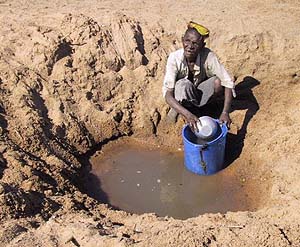 |
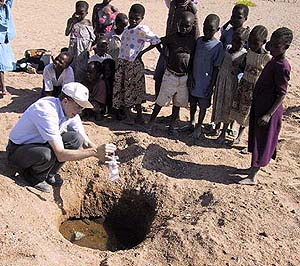 |
|
| A man collects drinking water from a hole dug in a dry river bed near Mwamanongu | Local children watch as Dr. Metcalf collects water samples in Nkoma |
In addition to pasteurizing contaminated water, solar cookers are also critical for cooking without traditional fuel. The burning of fuelwood and charcoal account for 90% of total energy usage in Tanzania, a country of 32 million people. In the villages, women walk 5-10 kilometers several times per week to collect fuelwood, and then cook over smoky fires. This is not only exhausting and unhealthy, but also time consuming, preventing participation in more productive activities. "I'm tired all the time from collecting fuelwood," said a young woman with a baby on her back and an infant in tow walking to the AHEAD clinic in Mwamanongu. In towns where firewood cannot be gathered, the cost of charcoal is enormous - up to 1/3 of their food budget. In Mwanhuzi, the cost of a five-gallon tin of charcoal is the same as the cost of a kilogram of beans or rice, food enough for several days! In Meatu, with the annual income per capita less than US $85 per year, spending money on charcoal instead of food contributes to hunger and malnutrition. The country's use of fuelwood and charcoal is not sustainable, and the costs increase yearly. One energy source which Meatu has in abundance, however, is sunshine. We built three CooKits from scratch and I also made two solar box cookers out of the boxes I had shipped my materials in. I used polyester film instead of glass for the window material. These cookers generated enormous interest amongst businesswomen in Shinyanga, resulting in a demonstration being organized by Elvira. It is thrilling to have SCI's work reach remote locations like those I visited in Tanzania. This has implications for 2.5 billion people worldwide who depend on diminishing amounts of traditional fuels, and don't know that with sunshine there is an alternative to fire. The addition of microbiological testing and water pasteurization should help attract attention to the unique role SCI has in the world! Contact: Dr. Bob Metcalf, 1324 43rd Street, Sacramento, California 95819, USA. Tel: (916) 278-6438, fax: (916) 456-2708, email: rmetcalf@csus.edu; Elvira Williams, AHEAD, P.O. Box 2049, Rockville, Maryland 20847-2049, USA. Tel: (301) 530-3697, fax: (301) 530-3532, email: aheadinc@erols.com
Africa and Europe
South Africa
Anjali, a 13 year-old girl from Durban, recently won an award for her solar cooker-based school science project. Way to go Anjali! She chose to do a project in the "energy innovations" category, and was so impressed with the low cost and safety of the CooKit solar cooker that she based her design on it.
Tanzania
Sperancea K. Gabone of the Kilimanjaro Biogas and Solar Center has been busy spreading solar cooking knowledge in Tanzania. In early March she served as a representative of the Mkombozi Community Development Group at World Women's Conference Day in Tanga, where she demonstrated solar cooking skills and technology to conference attendees. She also led demonstrations at the Mkombozi Vocational Training Center's open day, which had a guest of honor from the French Embassy and a representative from the Kilimanjaro Regional Commissioner's office, who vowed to extend solar cooker technology throughout the Kilimanjaro Region and parts of the Lindi region. In addition to these events, Ms. Gabone has been training women development groups from the Augaza Women's Center, the Mkombozi Community and the Solar and Biogas Community (SOBICO), and plans to continue teaching women's groups in the Kilimanjaro Region. Contact: Sperancea K. Gabone, Kilimanjaro Biogas and Solar Center, P.O. Box 7322, Moshi, Tanzania.
The Americas
Ecuador
Dr. Fabiola Cuvi, an honorary advisor to Solar Cookers International and director of the Ecuadorian Institute of Research and Training for Women (IECAIM), writes in appreciation of the Solar Cooker Review. The Review is useful for students of IECAIM's solar cooking courses, which enable women to build, use and sell solar cookers. A booklet describing some early accomplishments has the following anecdote: "Father Collin Mac Innes ... did not believe that the solar kitchen of IECAIM was going to cook, and, slapping the shoulder of Professor Rodrigo Carpio, said 'You are dreaming, my dear friend.' At noon, Father Collin and all those present savored the delicious chicken, eggs and potatoes which we cooked. The oven was proven to work." Courses have been taught since 1994. Contact: Dr. Fabiola Cuvi, IECAIM, 6 de Diciembre 2817 Republica, Quito, Ecuador. Tel: 593-2-525-517, fax: 593-2-563-232, email: pokar@pi.pro.ec
Nicaragua
 This
photo shows a wooden solar box cooker used by Mauritza Blas, of San Juan de
Oriente. She uses the cooker to dry clay beads prior to firing for ceramic
necklaces. The photo was taken by Christine Sabin of the Sacramento, California,
sister city organization Friends of San Juan de Oriente. Contact: Ron Rivera,
Potters for Peace, AP 3868, Managua, Nicaragua. Tel: 505 2 278 4904, fax: 505 2
277 3807, email: intrmnic@nicarao.apc.org.ni
This
photo shows a wooden solar box cooker used by Mauritza Blas, of San Juan de
Oriente. She uses the cooker to dry clay beads prior to firing for ceramic
necklaces. The photo was taken by Christine Sabin of the Sacramento, California,
sister city organization Friends of San Juan de Oriente. Contact: Ron Rivera,
Potters for Peace, AP 3868, Managua, Nicaragua. Tel: 505 2 278 4904, fax: 505 2
277 3807, email: intrmnic@nicarao.apc.org.ni
The Agency for Environmental Health is currently implementing a solar cooking project in the community of Agua Zarca. Writes their Executive Director Kathy Dickerson, "Of the residential energy consumption [in Nicaragua], 93.7% is derived from wood. ... Searching for firewood prevents some girls from attending school, and prevents women from engaging in other productive tasks. In addition, smoke produced from the wood fires increases health risks for the entire family from prolonged smoke inhalation." Unlike some cooking projects dedicated solely to women, men are encouraged to participate in this project. "Involving men from the beginning not only provides support for the women, " says Ms. Dickerson, "but also gives them a role when minor repairs are needed." Contact: Kathy Dickerson, Agency for Environmental Health, P.O. Box 850977, New Orleans, Louisiana 70185, USA. Tel: 504-894-1411, email: aehngo@earthlink.net , web: www.aehngo.org
United States
California
 Longtime
SCI volunteer Don Coan recently held a solar cooking demonstration at the
Effie
Yeaw Nature Center in Sacramento. Approximately 40 people attended, where they
witnessed the successful cooking of Teriyaki chicken in a CooKit, chocolate
cookies in a solar box cooker, and the canning of tomatoes in a Global Sun
Oven.
Contact: Don Coan, 640 38th Street, Sacramento, California 95816, USA. Tel:
916-457-0213.
Longtime
SCI volunteer Don Coan recently held a solar cooking demonstration at the
Effie
Yeaw Nature Center in Sacramento. Approximately 40 people attended, where they
witnessed the successful cooking of Teriyaki chicken in a CooKit, chocolate
cookies in a solar box cooker, and the canning of tomatoes in a Global Sun
Oven.
Contact: Don Coan, 640 38th Street, Sacramento, California 95816, USA. Tel:
916-457-0213.
Utah
 Galen
Schuck continues to build and utilize effective solar cookers made from simple
materials including cardboard and wood. The slower, gentle solar cooking process
works out perfectly for Tina Hadge, a friend of his from California, who puts
her food out in the morning and lets it cook all day while she works her herb
farm and lamas. At the end of the day her food is piping hot and ready to be
eaten. Contact: Galen Schuck, 10049 Majestic Canyon Road, Sandy, Utah
84092-4523, USA.
Galen
Schuck continues to build and utilize effective solar cookers made from simple
materials including cardboard and wood. The slower, gentle solar cooking process
works out perfectly for Tina Hadge, a friend of his from California, who puts
her food out in the morning and lets it cook all day while she works her herb
farm and lamas. At the end of the day her food is piping hot and ready to be
eaten. Contact: Galen Schuck, 10049 Majestic Canyon Road, Sandy, Utah
84092-4523, USA.
Asia and Pacific
Vietnam
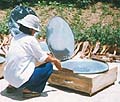 Nguyen
Tan Bich is organizing solar cooking workshops through Da Nang
University, the
first of which was held in May in Dien Phuoc village in the Quang Nam province.
Nine women and one man attended the workshop, where they learned the solar
alternative to cooking with straw, the traditional fuel. Topics of the four-day
workshop included how and why to use a solar cooker, how to build a solar
cooker, differences between types of cookers, and solar water pasteurization.
Upon completion of the workshop, participants were put on a waiting list to
receive a cooker, which Nguyen manufacturers with the assistance of poor and
handicapped locals earning a decent wage (see photo below).
Nguyen
Tan Bich is organizing solar cooking workshops through Da Nang
University, the
first of which was held in May in Dien Phuoc village in the Quang Nam province.
Nine women and one man attended the workshop, where they learned the solar
alternative to cooking with straw, the traditional fuel. Topics of the four-day
workshop included how and why to use a solar cooker, how to build a solar
cooker, differences between types of cookers, and solar water pasteurization.
Upon completion of the workshop, participants were put on a waiting list to
receive a cooker, which Nguyen manufacturers with the assistance of poor and
handicapped locals earning a decent wage (see photo below).
Contact: Nguyen Tan Bich, Hop Thu So I Buu Dien Thach An, Xa Binh My Huyen Binh Son, Tinh Quang Ngai, Vietnam.
by Christopher Gronbeck SCI board president
It can be difficult to relate to far away things. How much more compelling is the need right in front of you than the need half-a-world away! Fortunately, the gift of compassion bridges the distance, allowing us to identify with and connect to people we'll never meet. Much of SCI's work involves designing, administering, and evaluating projects in refugee camps and communities in Africa. Reports on the status of our projects concern days of sunshine, inventories of solar cookers, bank account balances, training session attendance, and other logistical and administrative data. But I recently had the opportunity to review a report from our Kakuma refugee camp project in Kenya. In the report, there are interviews with refugees who participate in SCI's programs and who have had their lives changed by solar cooking. While the statistics and figures in the report are important for monitoring the project, it was the interviews that told the human side of the story, which, in the end, is the only chapter that matters. Stories are an integral part of any culture. They describe the subjective beauty, the human nature, the threads of meaning that we all share. Permit me to share with you a few of the Kakuma interviews that reminded me that solar cooking is a beautiful thing.
- Lokamu Lojo, 68 years old. "He says that solar cooking has made a difference in his life. This is because he leaves his food cooking as he attends reading classes for the blind, that he has no worries as he stays in the class as his maize and beans will not burn and when he gets home it will be cooked. He says that incidents of burning from using open fires have reduced."
- Nasro Osman Umar, 45 years old. "I usually solar cook most of the time when the conditions are right and I make a saving because charcoal and firewood are expensive. I wish I could have two CooKits. My family of nine members loves the taste of solar cooked food."
- Rebecca Ang'eth Dit, 67 years old. "She says she enjoys cooking tea, meat and rice with solar. She says since she is toothless, she leaves it to cook longer until it is very soft and she has no worries with it burning or wasting her firewood. She also does not get burnt or tired from cooking."
- Hussein Adbulahi, 35 years old. "I only became blind two years ago and life has never been the same. I have had to depend on relatives and so I decided to be trained in solar cooking so that I can do my own cooking. I usually cook pasta, rice and potatoes. I love solar cooking because I do not burn the food and because I get time to rest. My neighbours feel encouraged to go for training when they watch me cooking using solar."
SCI's projects involve tens of thousands of families in several countries, but in the end, every individual participant has a story. This story is part of their wonderful, complex, beautiful lives, and we need to be mindful when we're reviewing columns of numbers in reports that there are human beings on the other end who have amazing lives and amazing stories just like we do. This simple act of acknowledgement helps us connect to the people we reach out to, illuminating the human nature that we share and allowing our compassion to bring us together.
Egyptian University Graduates Discover Solar Cooking Benefits
by Louise Meyer SCI honorary advisor
Every time I am in Switzerland I contact Group ULOG, a solar energy organization founded in 1980 by Ulrich and Lisel Oehler. I am indebted to Ulrich, who introduced me to solar cooking in 1985. Recently, I spent time in their home-office looking through new English versions of ULOG's documentation and discovered information on solar cooking in Egypt. A trip to Egypt was on my agenda for July 2000. Amidst the documents were intriguing reports of an elementary school teacher from Berne, Switzerland, who has spent one month each summer since 1993 teaching solar cooking in Egypt. The teacher, Annemarie Wenger-Marti, trains women to solar cook, and requires them to keep notes so that she can monitor progress each year. Annemarie impressed me as being a well-organized, demanding Swiss schoolteacher. In addition to her work in Egypt, she teaches solar cooking to local school children, including a group of fourth graders who built solar box cookers and used them on a 5-day camping trip! This past July I called Annemarie and told her I wished to do a site visit to the areas where she had been training and interview some of her students. With her permission, I headed off for Egypt to meet her contact, Dr. Wadid Eriam, a professor and soil specialist at Cairo University. Dr. Eriam, who spoke highly of her teaching skills, set up Annemarie's training program in 1990 as part of the larger Homestead Project. Goals of this unique project include: desert reclamation, employment and land-ownership assistance for agronomy students, and the creation of towns. Annemarie's students are literate, university graduates in agronomy, who made an independent choice to learn how to solar cook. They have the means to cook with gas if they choose. I have worked with refugees in Kenya and Ethiopia who needed solar cooking for survival, but haven't met cooks who had the freedom of choice - to decide for themselves to solar cook. They each paid US $30 for a locally built ULOG solar box cooker.
Louise admiring a ULOG cooker at work
Our first interview was with Mona Abdul Hakim of El Zohour, located in the Hamam Zone + Tiba Zone, popularly called the sugar beet zone, about an hour southwest of Alexandria. The day we arrived Mona was cooking beans and hard-baked eggs, in addition to drying watermelon seeds. She solar cooks most all local foods, including meat, eggplants, potatoes, fig marmalade, and a dish of stewed apples in shredded coconut. In the winter months she makes yogurt. Mona showed us her notebook, with solar cooker drawings and Arabic text, and a tote bag Annemarie had sewed and embroidered to carry food and a pot in. Mona likes to cook because she can put food out and forget about it - without worry of it burning. Her family finds the food tastier and healthier than conventionally-cooked food. Since learning to solar cook in 1998 she has become president of the El Zohour Solar Cooking Club, with the duty of organizing monthly potluck lunches where participants share news and recipes. The second interview was with agronomist Nahed Jussef and her husband Hashraf, who live in Zone #22. Like Mona, Nahed is enthusiastic about the benefits of solar cooking and is president of a local solar cooking club. Nahed and her mother learned to solar cook in 1998. Some of the foods she cooks are beans, dried peanuts, stuffed grape leaves, zucchini with rice and peppers, chicken livers, tomato soup and cakes. Next we drove to Zone #17 where we were welcomed by Hala Mustafa, the most dynamic woman of the three. She's a real solar cooking enthusiast with an entrepreneurial spirit. Hala told us that she had established a small business selling yogurt that she made in her ULOG solar cooker. In addition, she proudly showed us the Arabic-English cookbook Annemarie edited with her students that Hala would like to see published. Anxiously awaiting our visit, Hala had baked a cake with raisins just for us. She gave me the recipe: 5 fresh eggs, 1/2 kg. flour, 200 gr. sugar, 200 gr. butter, baking powder, and vanilla. She had chickens in her yard where her cooker was set up - the fresh eggs made the cake so much better! She let us taste the apricot marmalade and smell the solar-dried peppermint leaves. Otherwise her solar meals include: fish, beef, duck, mutton, rice, stuffed green peppers, stewed apples, dried peanuts, and watermelon seeds. She cooks every day. As we were about to leave, she took us over into her neighbor's yard. There, to our great surprise, we saw what looked like preparation for a birthday party! Hala's neighbor was baking two batches of creme caramel, one soft, one harder; and stewed apples, cored and stuffed with nuts and honey, laid out in a circular fashion in shredded coconut. These site visits incited me to want to learn more, even to have a video documentary made of these women that Annemarie had trained. Though I received answers to all of my original questions, I have many more. Who builds the cookers? How many potential new cooks are in this area? Did any of these cooks intend to become teachers to generate income one day? How much money do they save on gas? Recently Annemarie organized the construction of two parabolic cookers made from mirrors built by Alec Gagneux, an associate of ULOG. These cookers are part of a cafeteria built on a huge farm north of Cairo, where 300 farm workers join to share lunch and rest indoors. I will report on this project in an upcoming Solar Cooker Review. Contact: Louise Meyer, 3327 18th Street NW, Washington, DC 20010, USA. Tel: 202-328-6834, fax: 202-319-2074, email: lmeyer@ids2.idsonline.com; Group ULOG, Morgartenring 18, CH-4054 Basel, Switzerland.
Rotary / Girl Guide Partnerships
For some time now, Girl Guide Associations have worked with local Rotary Clubs to teach solar cooking to those most in need. Girl Guides are known for their community service and ability to organize. With funding from Rotary Clubs, these girls and young women conduct solar cooking workshops for youth and adults alike. Countries with joint projects include: Zimbabwe, Zambia, Malawi and Uganda. Girl Guide Associations in areas with cooking fuel shortages and local Rotary Clubs may obtain a free computer slide show diskette (for use on any Windows 95 PC) that explains in more detail how the partnerships work. For Girl Guide information and diskettes contact: Barby Pulliam, 3523 Rolph Way, El Dorado Hills, California 95762, USA. Tel: 916-933-1133, fax: 916-933-1134, email: barby@barby.com; for Rotary information contact: Wilfred Pimentel, 1035 East Cambridge, Fresno, California 93704, USA. Tel: 209-222-4193, fax: 209-222-6450, email: solarcook@worldnet.att.net
The Benefits of Planned Giving
by Fred Rogers
Last month I received a call from a friend and fellow financial planner, Bob Dreizler, who asked if I would talk to Virginia Callaghan about authoring a series of articles on charitable giving for Solar Cookers International. He had called me since he knew that I worked in the field of estate and gift tax planning. I have to confess that I had never heard of Solar Cookers International and had no idea what they do. But I was intrigued enough to meet with Virginia and her colleagues. I left their office with two vivid memories: one was a picture of a single stunted tree on what seemed an eternity of desert; the other was the inevitable realization of just how much time it would take to simply hunt for fuel to cook with. Everyday - forever. There's a common misperception about why people give to charity. A lot of people think it's only because of the tax deduction the Internal Revenue Service and state governments allow. But the tax deduction doesn't eliminate the cost of giving - it only reduces it. There must be something more. And there is. Studies of philanthropic behavior show that the most important reason why people give is their commitment to the mission and the specific programs of an organization. Every other reason, including tax incentives, is dwarfed by the importance of philanthropic motives. The personal satisfaction of supporting worthwhile causes drives charitable giving. For SCI, 75 cents out of every dollar used to promote solar cooking has come from past donations and gifts. In 1999 that figure was $280,949. Our aim is to increase donations. And that is where taxes become important. They can be used to motivate a basic giver - the person who needs a little "prompt" to make a financial commitment to SCI. And taxes are important since they can increase the size of a gift. If you can afford to donate $1,000 to SCI with after-tax dollars, and you are in a 39.6% tax bracket, then you can actually afford to give $1,656. The extra $656 will come back in income tax savings, reducing the net cost to $1,000. If we were able to leverage all of 1999's donations and gifts in that way we could increase SCI's budget to $465,147! We could further help communities worldwide achieve self-sufficiency in solar cooking and water pasteurization. We could make a world of difference. In future articles, I will discuss how - by making a gift to SCI - you can maximize the value of appreciated assets, how you can leverage a small contribution into a permanent endowment by the proper use of life insurance policies, and other tax-conscious ways to increase and stabilize the funding of SCI. Fred Rogers, Certified Financial Planner and investment advisor, may be contacted at 916-485-3473 or toll free 877-299-8080.
Willing Ways and the Power to Do Good
Solar Cookers International is making a world of difference for dear people and our planet. Your thoughtful, proportionate giving helps maintain a compassionate connection with those we reach through the spread of solar cooking.
Please consider:
- SCI in your will "I give and bequeath to Solar Cookers International of Sacramento, California $______ (or ______% of my estate) to be used for its humanitarian purposes."
- Legacy Investments / Stock Transfers See story by Fred Rogers.
- Sharing SCI's Story Share with friends and relatives the SCI story - how SCI is spreading simple solar cookers to further the happiness and prosperity of fuel-impoverished communities worldwide. In 1987, 17 fine folks, who enjoyed solar cooking in sunny California, came together to form Solar Cookers International. In doing so they accepted the challenge of teaching the world to cook with the sun. Today, SCI's ever-widening circle of benefactors and beneficiaries share the wonder and power of what this small group of people accomplished. Please visit our website, share this newsletter, and enlighten others toward the joy of SCI membership.
Please contact Virginia Callaghan at 916-455-4499 to discuss donations and stock transfers. Thank you.
by Virginie Mitchem SCI board member
One sunny Friday afternoon this past August my husband John and I drove from the Bay Area to Sacramento, California, where we shared in SCI's second annual Shine On celebration. The SCI staff and an impressive team of volunteers once again produced a beautiful event. The buffet table was loaded with salads, fruit, hors d'oeuvres, and special dishes marked with little red flags labeling them as "solar cooked." The assortment of quiches, cookies, chicken wings, solar roasted nuts, and crowd favorite Ethiopian honey bread demonstrated the versatility of the simple solar cookers many of the guests routinely use. This year, the sun was also represented in delightful ceramic pieces fashioned by local artists. The patio of the Sierra Health Foundation - with the Sacramento River as a backdrop - made an elegant gallery. On a table close to the entrance was a collection of dainty, brightly-colored baskets. On closer examination, guests discovered that these baskets were woven from plastic bags! The baskets came from Aisha, a refugee camp in Ethiopia where 2,000 families have learned how to cook with the sun. They have also learned to help keep the environment clean by using their weaving skills in a most unique way - creating useful household items from used plastic bags.
Containers woven from used plastic bags
Board member Dr. Bob Metcalf and Executive Director Terry Grumley presented photographs and stories from their recent trips to Africa. Terry's pictures brought us closer to SCI's distant staff and solar cooks in Kenya, Ethiopia and Zimbabwe. From Bob's presentation we learned about testing water for harmful bacteria and pasteurizing it using a CooKit. We also saw evidence that Bob snatched opportunities to solar cook whenever he could! The wonderful thing about Shine On events, besides the enthusiasm of staff and volunteers, is meeting people who have been SCI friends for years as well as people learning about SCI's work for the very first time. And Sacramento is the perfect place to learn, since the sun doesn't fail solar cooks. Thanks to everyone who worked to make this another enjoyable and very successful event.
SCI friends Susan Oliver, Linda Hayward and Cristal Johnson toast a successful evening
CooKit Use and Marketing Taught in Burkina Faso
by Wietske A. Jongbloed
Prior to development of the CooKit some years back, I had been working in Africa and using a solar box cooker. But while my daughter was working in Gorom-Gorom, a village in the northern Sahelian part of Burkina Faso, I decided to give the CooKit a try. I ordered two of them from SCI and tested them out while staying with her in 1996. The CooKits worked well and generated lots of curiosity and interest, so I ordered more for my second stay in Gorom-Gorom in 1997. During that stay I worked with a group of 20 women to experiment cooking local dishes. There, the staple food is millet broth, which is prepared in big 10-liter cooking pots over a wood fire with frequent stirring. Of course the stirring is to prevent burning, but it is also said to make the dish more airy. The group found solar-cooked broth unsatisfactory, but thoroughly enjoyed, amongst other things, solar-cooked rice, chicken, sauces, groundnuts, and tuber crops like sweet potatoes, yams and cassavas. Upon return to Holland we created the foundation KoZon, which means cooking with sunshine, to raise funds for projects. Acquiring funds in the Netherlands for solar cooker projects is not easy, as this is a rainy country where clear, sunny days are the exception, so solar cooking enthusiasts are uncommon. To make things worse, a very influential appropriate technology organization had some negative experiences in the early days with parabolic cookers, and thus continues to discourage those wanting to start solar cooking projects in developing countries. Another drawback in Holland is that it is difficult to find manufacturers willing to produce foiled cardboard, of which the CooKit is made. This is because cardboard recycling is very popular and foiled cardboard cannot be recycled without removing the foil first. In the end, volunteers helped us to glue foil to 300 pieces of cardboard which were then mechanically die-cut for us in the form of the original Nairobi CooKit (slightly different from the California model). Of course the CooKits should be produced locally in Burkina Faso, but only one packing factory exists there, and its cardboard is purchased from Côte d'Ivoire - resulting in costs approaching US $2 for the cardboard alone, without foil or cutting. They also do not have a machine to glue foil to the cardboard. KoZon hoped to commission a study by a local consultant to find out where CooKits could be produced for a reasonable price, whether in Burkina Faso, Mali, Côte d'Ivoire or Ghana, but does not have the funds to pay for such a study. We are now trying to find other ways to obtain this goal. The 300 hand-glued CooKits were mailed to Burkina Faso in 1999. Two-day demonstrations were given by six of the women recruited from those who were given a CooKit in 1997. Cooking was taught the first day, while the second day was a mixture of cooking instruction and lessons in marketing and selling CooKits. The demonstrations were given in six different neighborhoods of the village. As a lot of single men bought CooKits, we had one demonstration exclusively for bachelors. CooKits were sold with a black pot, two polyethylene bags and a cotton storage bag for 1500 CFAF (around US $2.50). With a pot and bags included this was a very reasonable price, a price that poorer women could afford to pay. They understood, however, that it was a subsidized price. The demand was great, and within 18 days all 300 CooKits were sold. Follow-up visits are conducted to assess the usefulness of a cooker - how often is it used, what is cooked, etc.
The training team
Packaged CooKits ready for sale
When I visited in April of this year I discovered that, unfortunately, there had been many dusty, low radiation days - resulting in fewer days when the CooKit was effective. While there we helped start the local, hand-crafted production of CooKits and hay boxes (an insulated pot-holding device, previously unknown to the villagers, that allows cooking to continue after a pot is removed from its heat source).
Foil being applied by hand
A tailor sewing the insulating hay box lining
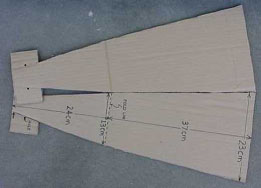
Interior of a finished hay box
In Holland we have now found a factory that is willing to make CooKits for us, but until production is realized, we will continue to produce them by hand. Contact: Wietske A. Jongbloed, Hollandseweg 384, 6705 BE Wageningen, Netherlands. Tel: 0317 412370, fax: 0317 410732, email: wiewen@bart.nl
Correction
In the August 2000 Solar Cooker Review we presented incorrect contact information for the organization Solar Innovations of Tanzania (SOIT). The correct information is P.O. Box 12809, Dar es Salaam, Tanzania. Tel: 00222 26 68721, email: sonet@twiga.com
Solar Cooker Review
Solar Cooker Review is published two or three times per year, with the purpose of presenting solar cooking information from around the world. Topics include solar cooker technology, dissemination strategies, educational materials, and cultural and social adaptations. From time to time we cover related topics such as women's issues, wood shortages, health, nutrition, air pollution, climatic changes, and the environment. Solar Cooker Review is sent to those who contribute money or news about solar cooking projects.
The suggested subscription price is US $10/year. Single copies are sent free to select libraries and groups overseas. We welcome reports and commentary related to solar cooking for possible inclusion. These may be edited for clarity or space. Please cite sources whenever possible. We will credit your contribution. Send contributions to Solar Cookers International, 1919 21st Street, Suite 101, Sacramento, California 95811-6827, USA. You may also send them by fax: 916-455-4498, or email: info@solarcookers.org.
Solar Cooker Review is compiled and edited by the staff of Solar Cookers International, with layout graciously provided by IMPACT Publications located in Medford, Oregon, USA. SCI is a 501(c)(3) nonprofit organization whose mission is to spread solar cooking to benefit people and environments worldwide.
Solar Cookers International
1919 21st Street, #101
Sacramento, CA 95811, USA
Tel: 916-455-4499
Fax: 916-455-4498
Email: info@solarcookers.org
Board of Directors
- David Anderson
- Consuella Brown
- Beverlee Bruce, Ph.D.
- Paul Funk, Ph.D.
- Christopher Gronbeck
- Linda Helm Krapf
- Barbara Knudson, Ph.D.
- Lorrie McCurdy
- Robert Metcalf, Ph.D.
- Virginie Mitchem
- Barby Pulliam
- Judith Ricci, Ph.D.
- Meredith Richardson
- John Roche
- Mary Ann Smith
- Claude Thau
- Elvira Williams
SCI’s mission is to spread solar cooking to benefit people and environments
